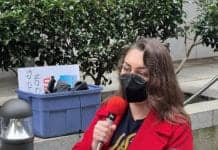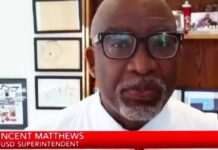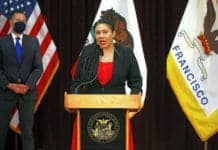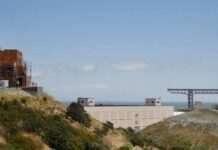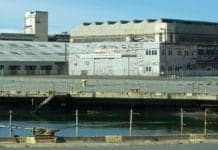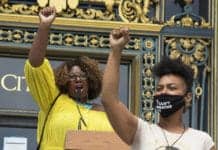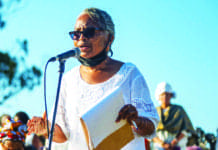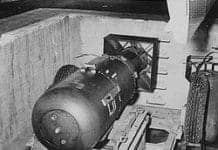
by M. Reza Shirazi, UC Berkeley
Mayor Breed, in her first State of the City address in January 2019, announced that she has partnered with Bayview District Supervisor Shamann Walton to request an independent analysis by representatives from the University of California San Francisco and University of California Berkeley to clarify questions around the testing at the Hunters Point Shipyard Project.
The Hunters Point Shipyard Project is part of the Candlestick Point-Hunters Point Shipyard Development Plan located along the southeastern shoreline of San Francisco, in the Bayview-Hunters Point neighborhood. It will create a new mixed-use community consisting of approximately 12,000 homes and several million square feet of retail, entertainment, hotel, office and open space.
Part of the redevelopment, Hunters Point Shipyard Phase II, sits on the former naval base, and has been under a massive remediation work led by the Navy and supervised by several federal and state regulatory agencies. It is conducted by a few different firms, including Tetra Tech Corp.
In 2017, an EPA evaluation of the remediation activities found widespread deliberate data falsification by Tetra Tech. For example: in Parcels B and G of the shipyard, covering 40 percent of the site, over 90 percent of samples were suspect.
Phase I of the Hunters Point Shipyard project in Parcel A, adjacent to Phase II, has been under construction since 2012, and with more than 300 residential units, is now home to hundreds of families. After revelation of the botched cleanup, residents of Parcel A demanded re-testing.
The California Department of Public Health conducted a surface scan from the public areas of the site and found no risk to the health or safety of residents and workers. But this re-testing, which was criticized for being incomprehensive and insufficient, did not help residents and community members feel safe or protected. Now, the mayor and District 10 supervisor believe that an impartial panel of health experts from two leading universities will end the controversy over safety.
For a while, no details were released about the panel – nothing about its composition, plan etc. Neither community members nor journalists nor my colleagues at UC Berkeley knew about the plan or research team. My requests for details from Supervisor Walton’s office did not succeed.
On April 17, a press release from the Mayor’s Office finally provided more details. We learned from this announcement that Mayor Breed, City Attorney Herrera and Supervisor Walton had asked UCSF officials in January to put together a plan to conduct an independent review of the radiation testing procedures used at the Hunters Point Shipyard.
We also read that the review has three phases and includes 10 weeks of information gathering and data analysis and four weeks of public presentation. But this announcement was anything but transparent; it didn’t say who the members of this expert panel are or what their expertise is. There’s no information on how these members were selected, why they have not been introduced to the public, what exactly their plan is, what “interviewing” people means – and there are still many other questions.
Fortunately, the UCSF staff introduced in the press release were kind enough to respond to my email, send me the names of the panel members, and a two-page document that explains the goals and scope of the review. Here is what I got from this plan and from my communication with UCSF:
This document is called “UCSF-UC Berkeley Committee to Review Hunters Point Radiation Testing Protocols and Data.” This suggests that the review is limited only to analyzing the “Hunters Point Radiation Testing Protocols and Data.” Members of the panel are John Balmes, MD; Tom McKone, PhD; Kirk Smith, PhD, and Kai Vetter, PhD. They are all senior experts from UCSF and UCB and are highly respected scholars from the fields of medicine, public health and nuclear engineering.
At the beginning, a request for assistance was sent to UCSF from the mayor, city attorney and Supervisor Walton. The UCSF Chancellor had forwarded the request that John Balmes, former chief of the UCSF Division of Occupational and Environmental Medicine at Zuckerberg San Francisco General Hospital, assemble the expert panel. Three other members responded to this call, volunteering their time and knowledge.
The assessment, which exclusively focuses on Parcels A and G, will “A) Review and comment on the appropriateness and sufficiency of the protocol used by the California Department of Public Health (CDPH) to test for radiation contamination in Hunters Point Parcel A; B) Review and comment on the results of the CDPH testing, focusing on the quality of the results for decision-making purposes; and C) Review and comment on the appropriateness and sufficiency of the protocol that is being proposed by the U.S. Navy to test for radiation contamination of soil in Hunters Point Parcel G.”
This indicates that assessment is limited to reviewing applied protocols for re-testing Parcel A, evaluating results of the test, and also reviewing the applied protocol for Parcel G.
The research team will interview representatives of the SFDPH, CDPH, U.S. Navy, U.S. EPA, Kathryn Higley from Oregon State University and Daniel Hirsch from UC Santa Cruz to gain “background on the protocols and materials related to the protocols.” The only engagement with community members will be “to hear firsthand community concerns regarding potential radiation contamination” and participating in a listening session with interested members of the community.
Since January 2018, I have dedicated all my time to doing research on the Shipyard Project and Bayview Hunters Point neighborhood. I have attended most of the community meetings, have reviewed thousands of documents, reports and media coverage, and have tried to dig into the long history of the problem. So, please allow me to raise my concerns about this review and its challenges.
Limited scope
Let’s start with highlighting a statement in the plan: “The Committee’s report will address and discuss published benchmarks regarding radiation exposure, but will not comment on whether Parcel A or Parcel G are ‘safe’ for residential development.” I ask myself – and this would be the question of most of the community members, including residents of Parcel A – if this independent review will not be able to say whether Parcel A is safe or unsafe, what is the purpose of this review?
I totally understand why the research panel doesn’t want to clearly comment on this critical question. They are experienced researchers and know that to answer this question requires more comprehensive review and maybe fieldwork research. But the problem is, that even after this review, residents of Parcel A and the wider community members will continue to live in an atmosphere of uncertainty.

Transparency
The call for an independent review came from the city authorities. They decided to do it (rightly, in response to the community concerns), and they decided to approach UCSF. They should have been satisfied with the plan proposed by the research team, and they didn’t want to disclose any details before finalizing everything. Total transparency! Very similar to what the Navy and many other regulatory agencies have done for a long time!
I even received an email from Supervisor Walton’s office requesting that I not make public the plan and other details I got from UCSF. I hope they have good reasons for this; it would be great if they shared why with us. This request surely contradicts the mayor and supervisor’s statements in the press release that the Bayview Hunters Point community deserves transparency and accountability with regard to the cleanup.
If this independent review will not be able to say whether Parcel A is safe or unsafe, what is the purpose of this review?
How can transparency be achieved while the community is not actively involved in this process? This is a serious question Mayor Breed and Supervisor Walton should answer.
Inclusion
When I asked UCSF why community members won’t be included, the response was, “The scope of the Committee’s work is a scientific review.”
Does this mean that to be “scientific” is at odds with including community members? Or, does it mean that including community members makes the work less “scientific”? Or, do community members not know about “science”? Or, that there is no one from the community with enough “scientific” qualification to join the committee?
I assume members of the committee are aware that conducting research directly addressing community health issues requires active community engagement and involvement. And they hopefully likely agree with me that in the current format, the review is going to be done very much in isolation from the community.
Participation “in a listening session with interested members of the Bayview Hunters Point community, hosted by Supervisor Walton, to hear firsthand community concerns regarding potential radiation contamination of the former Hunters Point Naval Shipyard,” as the plan suggests, is not “active community involvement.”
I would argue that in this review, “community” is, to a great extent, excluded, and this has been the trend over the last 20-25 years with regard to the Shipyard Project. Community oversight and active participation – please note, this is fundamentally different from passively informing the community – a long-standing demand of the community, particularly after the dissolution of the Restoration Advisory Board in 2009, that has been always ignored, is still a valid demand.
Does this mean that to be “scientific” is at odds with including community members? Or, does it mean that including community members makes the work less “scientific”? Or, do community members not know about “science”?
Distrust
If I were to describe the current atmosphere that governs the Shipyard Project and its relation to the community I would call it, with utter certainty, an atmosphere of distrust. This review is going to be conducted, understood and interpreted in a context of prevailing distrust between the community and various city, state and federal agencies. In this sense, my colleagues are stepping into highly toxic land, contaminated with this situated distrust.
It is out of the scope of this article to explain how this distrust emerged, grew and dominated. But evidence is abundant. Such loaded context jeopardizes acceptance and perception of the results of the review, even if it comes from a highly respected panel of experts. The review faces a huge challenge.
I wish city authorities would engage the Bayview Hunters Point community in its process of decision-making for this review. I wish they had published the plan before starting work. I wish the committee included members of the community. I wish they had discussed the plan in a community meeting or a press conference before starting it, showing their good will and good intentions to the community.
I finish my wish list here – though it could be much longer. Now, it is too late to see my wishes fulfilled! It seems the research has already started. Decisions have been made, and they are less likely to change the “tasks” of the plan.
But there is still a possibility to make the review more inclusive and transparent. Here are my suggestions to the committee:
1. Expand the interview list to include members of the community. A meeting for collecting community opinion is insufficient.
2. Run focus group discussions with community members to gain in-depth understanding from the community and their concerns. This may build trust between reviewers and the community, assuring them that they are heard.
3. Include members of the community on the committee. There are qualified neighbors who can easily add to the scientific quality of the committee.
4. Propose a clear plan to the community for the post-review era. If you can’t say whether Parcel A is safe or unsafe, explain to the community what needs to be done in order to answer this question and who can provide such a response.
And my recommendation to city authorities: Don’t promise transparency! Do transparency! If you think what you have done is already transparent, maybe you should revise your definition of transparency!
My senior colleagues have stepped into a toxic land! It is a land contaminated by chemicals and radioactive materials but, more importantly, a land full of distrust, ignorance and injustice. I respect their courage to step in, and I hope they manage to persuade the community that their work is inclusive, reliable and helpful for making them feel safe. At the end, I join Mayor Breed and repeat her words: “This community deserves transparency and accountability.”
M. Reza Shirazi is Marie Curie Global Fellow at the Institute of Urban and Regional Development (IURD) at UC Berkeley and a senior research fellow at the School of the Built Environment, Oxford Brookes University in the U.K. He is principle investigator of the European Union project “Socio-Spatial Justice in Urban Neighborhoods” and is experienced in coordinating and directing international partnership projects, particularly with developing countries and the Middle East. He has organized and guided numerous international events and workshops worldwide about neighborhood and community development, participation and sustainable development and can be reached at shirazi@brookes.ac.uk.

 Store
Store



